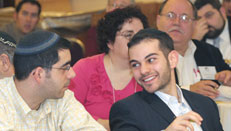 |
 Symbols play an important part in helping to define who we are. Our clothing for example is often symbolic of the social milieu with which we identify. Corporate logos help to create a business image and flags of a nation symbolize its essence. Our biblical commentaries often interpreted the text in symbolic fashion. No where is this more evident than in the interpretations regarding the construction of the tabernacle. The detail upon detail upon detail described in the Torah led the commentaries to find symbolic meaning. It was hard to imagine that the Torah would spend so much detail if all it was telling us was the architectural make up of the mishkan. While we can readily understand the basic (non-symbolic meaning) of such items as the aron which housed the tablets or the menorah or the mizbeach (altar) at least one of the key items in the mishkan seems to defy comprehension.
"Make two golden cherubs hammering them out from the two ends of the cover...The cherubs shall spread their wings upward so that their wings shield the cover. The cherubs shall face one another but their faces shall also be inclined downward toward the cover (25:18-20)." Why did G-d command that the image of two children shall adorn the ark? Was this not a violation of the second commandment ordering us not to make graven images? The first lesson of the cherubim is that G-d defines for us what is right and wrong. While the cherubim in another context would be idolatry, the fact that G-d commanded them here means by definition that they are not idolatrous. While this may not seem rational to us, it does to G-d. The Torah is hinting that there is a fine line between worship of G-d and idolatry; between proper service of G-d and misuse of mitzvoth for personal gain. It is interesting that the term used to describe idolatry is avodah zara , literally strange service. Avodah, service is one of the three pillars (along with Torah and gemillut chasadim )on which the world stands (Pirkei Avot). Zarah comes from the root zar meaning strange. Idolatry is service of G-d that has just lost its proper focus. It is service, it is just strange. Unfortunately many who worship G-d instead of using the objective standards of the Torah taint their service by injection of uncalled for subjective motivations.
The cherubim themselves seem to point to the proper direction for service of G-d. There were two of them, in the image of children, facing downwards with their wings pointing upwards. We can never worship G-d alone. This is one of the key functions of marriage; to provide us with a partner who can help us in the proper service of G-d. We need to work with members of our community for its betterment. Service of G-d requires partners. But service of G-d also requires that we take on some of the characteristics of children. The purity, innocence, faith, that adults seem too sophisticated for, is the hallmark of children and the path to reach G-d. The corrosion of the real world, which shatters the illusions of our youth, must not harden our relationship to our master. Children tend to have a natural love of ritual, it is so sad when adults try to squelch that natural yearning for G-d. Perhaps we are all a little too sophisticated living as we do in such a "modern" world. We must bring back our youthfulness. But while emotionally we must be children in the service of G-d, intellectually we must strive for higher and higher goals. Our understanding of Torah must not be allowed to remain on a grade two or even on a grade eight level. No wonder so many adults do not appreciate the beauty of Torah. Their general education is quite high whereas their Jewish education remains on an elementary level. The cherubim have their face looking towards the Aron, which houses our Torah but their wings are pointing heavenly. If we focus on Torah there is no limit to what we can accomplish. Shabbat Shalom!
|
 |








